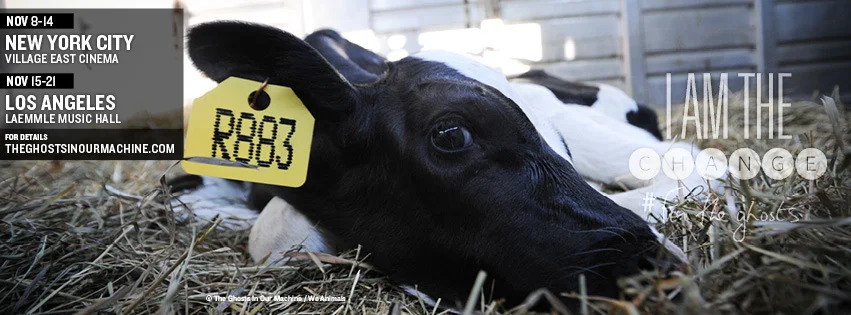"The Ghosts in Our Machine" Film Review
/“Many documentaries steeped in social or political issues get very insistent and often very noisy in expressing a point of view… In contrast, "The Ghosts in Our Machine," a heartfelt meditation on animal rights, comes at you as a whisper.” –Betsy Sharkey, Los Angeles Times Film Critic, review dated 11/14/13
“In compelling and moving artistry (and without graphic violence), the film explores the emotions of factory-farmed animals vs. farm animals in protective sanctuaries. We also see how friendship and stewardship of farm animals bring safety and joy to their lives, and uplifts the human spirit.” –Forks Over Knives, Facebook post dated 11/16/13
“People will not encounter the graphic imaging of the documentary “Earthlings” and they will not be bombarded with statistics and numbers given in the documentary “Food, Inc.” The film is about the true essence of what empathy is supposed to be.” –Liliana Danel, examiner.com, review dated 9/30/13
We saw “The Ghosts in Our Machine” in Los Angeles last evening, and are grateful to the film-maker Liz Marshall, photographer Jo-Anne McArthur, and the entire cast and crew for making such a beautiful and hopeful film.
As some of the professional reviewers have mentioned, this film is not nearly as graphic as other documentaries exploring the relationship between humans and other animals, but it still manages to evoke a wide range of emotions (yes, including some tears) through both haunting and joyful images.
There is one segment featuring Dr. Temple Grandin, who is championed by some for designing slaughterhouses which enable what they deem to be humane killing of cattle. Dr. Grandin calmly describes each step of the architectural rendering in detail. The accompanying footage shows how live cattle are led through the process all the way up to, and including, the actual slaughter. Some people were bothered by the inclusion of Dr. Grandin, as it may have seemed to condone the notion of “humane slaughter.” However, this inclusion is part of what makes this film appealing to a general audience rather than just animal rights activists. The film offers no judgment as to whether this is acceptable or not, but rather lets Dr. Grandin present her explanation, and leaves it up to each viewer to decide for themselves.
There are also scenes of a mother cow and calf from the dairy/veal industry. The footage of this part is filmed at an organic, certified humane dairy, not at the worst factory farm they could find. And again, the film does not tell the viewer whether this is wrong or right, but simply presents the information for each person to make up their own mind.
As the protagonist and photographer Jo-Anne McArthur mentions in the film, most people want to be compassionate, and will be compassionate, if given the chance. Part of the beauty and brilliance of the tender approach of “The Ghosts in Our Machine” is that it will appeal to thoughtful, caring people who are not animal rights activists (nor want to be). A greater awareness of empathy and compassion towards all living beings, whether human or not, can only be a good thing.
It is currently screening in Los Angeles at the Laemmle Music Hall 3, and in New York at the Village East Cinema. It will screen in Columbus, Ohio at the Gateway Film Center and in Chicago, IL at the Music Box Theatre starting December 6. Check the Ghosts in Our Machine website for other screening dates. Please go and see this wonderful film if you can.
Thanks for reading. Peace and love to all who live.
Susan

